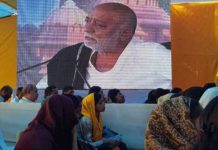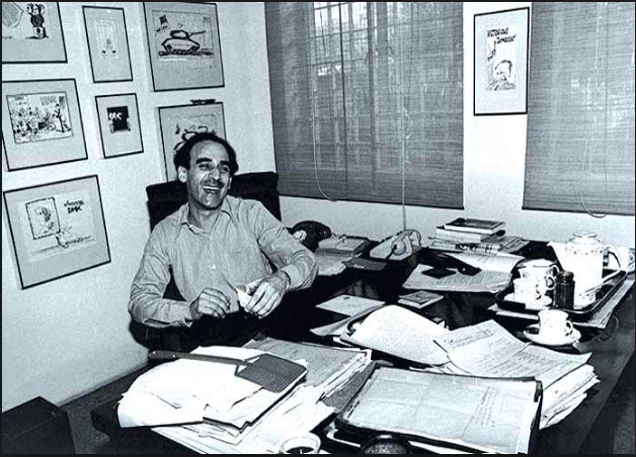(newspremi.com, Sunday, 21 જૂન 2020)
(Ayodhya, Sunday, 23 December, 2020)
Ganika is at the centre of society: Morari Bapu
Pujya Morari Bapu began the second day of ‘Manas: Ganika’ in Ayodhya with these lines by Sahir Ludhianvi:
yeh purpech galliyan, yeh badnam bazar
yeh gumnam rahi, yeh sikkon ki zankar
yeh ismat (self respect) ke saude, yeh saudo pe takrar
jinhe naaz hai hind par woh kahan hai?
Before reading the full poetry, he pointed out : ‘what the so-called ilmy couldn’t dare to speak…,’ he left the sentence unfinished. Ilmy is an urdu word which means: learned, pundit, maulvi or litterateur. Maybe Bapu wanted to rhyme ilmy with filmy, but left the sentence suspended in space perhaps out of respect for the laureates. The truth (of red light areas) that all these ilmy couldn’t utter, came from the pen of a filmy song writer.
In the context of Sahirsaab’s exemplary boldness Bapu says, ‘…we have to accept the truth. It’s okay if we are not brave enough to be the torchbearers, that can be forgiven, but denying the truth once it is already out is criminal and unpardonable. Truth must be embraced. And I believe telling the truth requires bravery, but accepting it demands an even bigger courage. People are not prepared to even just stand with the truth. That which is there, that which is existing among us.’
Bapu says: all they seek is to see a compassion in your eyes towards them.
Before continuing with this famous poetry of Sahir, Bapu shares: ‘I have received a very good news. Arrangements are made in Kolkata (at the infamous red light area of Sonagachi) to show this katha live on a big screen to these behen-betiyan and they are also offered the lunch-prasad after katha. (Note: throughout the nine days of katha Bapu addresses the group of ganika only as ma-behen-betiyan i.e. our mothers, sisters and daughters.) Same is arranged in Mumbai as well. I want to appeal to all my fellow Indian citizens, make such arrangements in these areas in your cities, put up big tv screens where ever possible, and request them, tell them: Bapu is inviting you to watch, please come and listen to katha and please take lunch-prasad from lord Ram of Ayodhya. I feel really jubilant on hearing about this. Make it happen in places like Surat, Vadodara, where ever possible, with the efforts of those of you who are willing to do it. It has already begun organically and the blessings of sages are there with you, just do it.’
Bapu returns to Sahir Ludhianvi: ‘Sahir is imploring us— where are the people who want to protect the pride of India? Why aren’t they here, where have they vanished? I am referring to all of you, with all due respect, I want to appeal to every realm of the society, look at the agony of these words. For these ma-behen I want my voice to reach even Delhi: where is everybody?’
woh ujale darichon mein payal ki chhan chhan
thaki hari sanson mein tabale ki dhan dhan
yeh beruh kamaron mein khansi ki thhan thhan
jinhe naaz hai hind par woh kahan hai?
Bapu says: ‘Sometimes people are so victimised due to bad circumstances, they don’t want your money, they don’t mind if you don’t support them even, all they seek is to see compassion in your eyes towards them.’
Bapu continues to quote Sahir and adds, even Tulsi in his Vinay Patrika talks about alleviating the suffering of ganika, not just that, Guru Granth Sahib too has graceful mention of ganika.
Today is just the second day of ‘Manas: Ganika’. Bapu wastes no time in slowly gathering speed on the runway and then taking off, no, he just blasts off like a rocket, taking katha straight to the skies, out of the pull of gravity. Those who don’t have ulterior motives behind their actions can free themselves from the commonplace ideas and think out of box, because they don’t have an iota of fear of ‘what will people say’. Like a floating feather, Bapu is totally out of reach of any gravitational burden today. He says: ‘I don’t want to give you a shock, but if it comes as one, please know that it is the result of your own stagnant thinking and inertia. Brace yourselves for what I am about to say: Ganika is a guru. Ganika is a guru. Ganika is a guru. Bhagavan Dattatray has made a list of twenty-four kinds of gurus. One of which, he states, is ganika. How will you deny it? It is difficult to turn your back on ties that are centuries old, no correct that, not centuries, these ties are dating back several millennia…’
Bapu says: now write down what I am saying, not on paper, in your heart and mind: ganika is a shukan (good omen) for the society.
Bapu continues, ‘We live in a world where people are constantly busy plotting their cunning little schemes. The so-called straight arrows of society are not always playing it straight, they play such sly games. Just yesterday evening I was telling this to some people who were sitting by me. I said, ‘I can clearly see who is scheming what, but my sadhuta (spirituality) is stopping me from tackling them.’ If they think I am unaware of the games they are playing around me, the schemes they try to set up, I want to tell them this—think again. It’s true I didn’t go to college and get a big degree but I’m not a simpleton. Keep that in your mind.’
Bapu is in elements today and why not? This is Ram katha in Ayodhya itself. The land of Ram and the book of Tulsi is literally a match made in heaven. It’s no wonder that katha is euphoric here.
Bapu says: now write down what I am saying, not on paper, in your heart and mind: ganika is a shukan (good omen) for the society.
Certain things are considered good omen in our culture— a cow feeding her calf, a saubhagyavati (an indian married woman), a brahmin carrying pothis (books)— all these, and many others, are considered good omens when you encounter them perchance on your way somewhere. One among them is when you happen to pass a well dressed ganika in your journey to some fruitful and important work. In West Bengal they make earthen statues of Durga during Puja days and till date the first auspicious fist of mitti (soil) is taken from a ganika’s front yard. The earth from a ganika’s courtyard makes Durga idols. Just think about it! What a powerful mitti it must be to represent goddess Durga. But we look down upon the same house which gives the soil for making Durga. In the next room her sick child maybe coughing up and somehow she will continue… yeh khansi ki thhan thhan… what a keen observation of Sahirsaab! Someone has written to me: Bapu, why don’t we make a Medical Welfare Scheme for these behen-betiyan, it can be in Delhi or Mumbai, wherever convenient. A fund for free medical aid and other financial support to the sick among them. Do it yaar, it is high time. Gather up and make it possible. Do something. I am not the man for managing committees etc, but you all can do it. There is a lot that needs to be done. Jinhe naaz hai hind par woh kahan hai, kahan hai… By the grace of lord Ram and with the blessings of babaji (head mahant shri of shilanyas trust) I appeal to you from this abode of shri Ram, from this land of Manas, from this Ayodhya— team up and raise a respectable fund for this good cause. Whatever sum gets accumulated, allocate it where money is badly needed for their welfare. Take guidance from those already doing ground work there. Let me be the first to give, this vyaspeeth makes a contribution of Rupees eleven lacs (1,100,000) as a prasad from Hanumanji of Talgajarda. Those of you who want to make any contribution meet Harishbhai from today onwards, till next Saturday. He will note it down. Let’s keep Saturday as the last day, whatever amount is collected by then, will be distributed to the organisations working in their interest. I want us to do something worthwhile for them before leaving Ayodhya…
Bapu quotes Tulsidas from Vinay Patrika and says: At one point Goswami Tulsidas questions lord Ram and says,‘you are a saviour of sadhu and sant, which is only natural, but you save and uplift ganikas too! Pray tell me lord, what is your connection to them? What ties do you have to them?’
Bapu continues: ‘I found it very surprising and thought provoking,‘What ties do you have to them?’— I wondered why Goswami Tulsidasji used such sarcasm? Some interpretations stand ground on their own, you don’t require any written proofs to support them, it is enough that they be spoken by a buddha-purush (an enlightened man). Sadhu bole so nihal. History requires recorded facts and proofs to establish anything as the true or false, spirituality recognises truth in its bare form, making facts and proofs obsolete. So I started thinking, what is the link between shri Ram and ganika? The answer is in Valimiki Ramayan, Chakravarti Rajgopalchariji has also noted in his book that Lomasji has narrated this fact to Pandavas in Mahabharata. But we are not ready to look at these things with an open mind because of our pseudo-intellectual snobbery, our pretentious status quo. Gandhiji has shown such good opinion for widows and for these behen-betiyan. Valmiki called them varangana (best of the beautiful women). There are clear references that these varanganas played an instrumental role in paramatma taking his human avatar as Ram. Ganika is at the centre of our society. Ganika brought us Ram. That is the relation, the tie. It’s a long story, those who are interested can go and read the original texts. There are people who will have a strong aversion to this truth because they want to protect their prejudices. They will approach it in a wrong way and deduce twisted conclusions. Ram says: You helped me take my avatar, though I am omnipresent, but you contributed to my manifestation as Ram on this earth. It’s there for you to read in Valmiki Ramayan. Some so-called intellectuals took this reference from Valmiki Ramayan and tried to popularise a very distorted image of it. That was very wrong… Ganika is guru, ganika is shukan (good omen), ganika contributes in making Durga and in the incarnation of Ram. Ganika is highly respected in our traditions.’
Manas: Ganika katha by Bapu is a historical katha which will make him remembered fondly as an eminent social reformer of our time in public memory for ages to come.
Second day of katha is reaching its crescendo. Bapu says: celebrate the birth of Jesus with joy. Sure, why not? Peacefully and joyfully remember Santa. And celebrate Ramnavami with double the fervour. Janmashtami with tripple the love. And Mahashivratri with four times the happiness. Jesus was great, he was pure, ganika is associated with his birth as well. The disciples of Jesus and their successive traditions may or may not look foolproof to us, that’s our personal choice, but Jesus himself is a different story. Such a cruel tradition was prevalent there, in those days. This kind of a woman was killed by pelting stones at her mercilessly and injuring her until she died. Even the pious believed it was the all right to do this. But Jesus said: He that is without sin among you, let him first cast a stone at her.
Bapu refers to one more poem by Sahir, bringing the second day of katha to completion: Aurat ne janam diya mardon ko…
And with that, the remaining lines from Sahir’s poem, the ones Bapu didn’t use in katha today, come to mind:
yeh saddiyon se bekhauf sehemi si galliyan
yeh masli huyi adh-khili zard kaliyan
yeh bikati huyi khokhli rang-raliyan
jinhe naaz hai hind par woh kahan hai?
yeh phoolon ke gajre, yeh peeko ke chhintein
yeh bebaak nazare, yeh gustakh fikare
yeh dhalke badan aur yeh beemar chahre
jinhe naaz hai hind par woh kahan hai?
yahaan pir bhi aa chuke hain, jawaan bhi
tan-o-mand bete bhi, abba miyaan bhi
yeh biwi hai, behen hai, maa hai
jinhe naaz hai hind par woh kahan hai?
kahan hai, kahan hai, kahan hai…
Dusk comes early to Ayodhya. By five in the evening it starts getting dark. By six it is almost total dark. Today evening a few of us were having a light conversation with Bapu. We were also relishing the privilege of sipping the steaming hot tea-prasad made from Ganga jal. Bapu shared: So many youngsters are listening to this katha. Quite a few of them are coming to me and confessing privately, ‘Bapu, even we have gone to them.’
Here I want tell him what so many readers are writing to me, that: ‘Manas: Ganika’ katha by Bapu is a historical katha which will make him remembered fondly as an eminent social reformer of our time in public memory for ages to come.
यह लेख हिन्दी में पढ़ने के लिये यहाँ मिलेगा
આ લેખ ગુજરાતીમાં વાંચવા અહીં ક્લિક કરો











